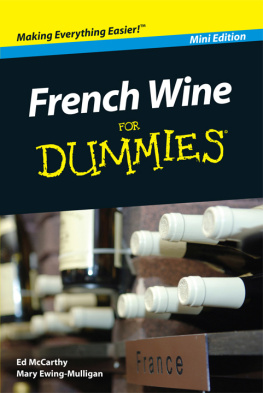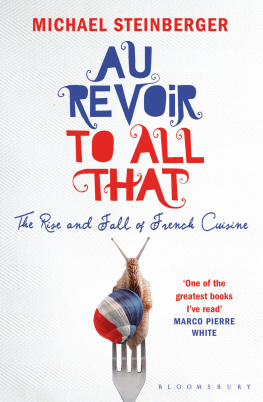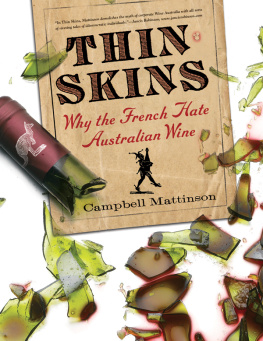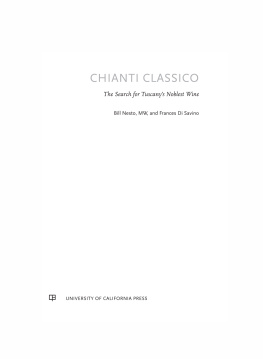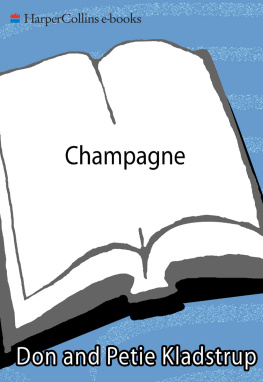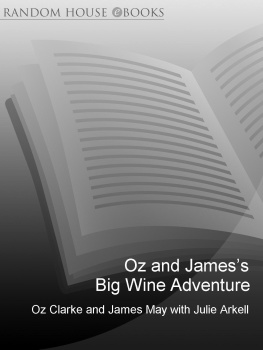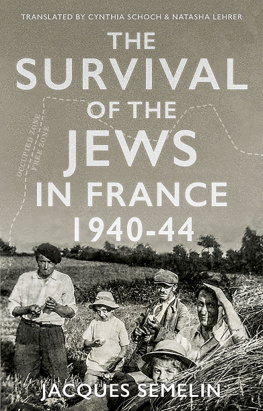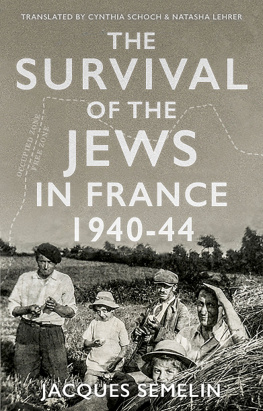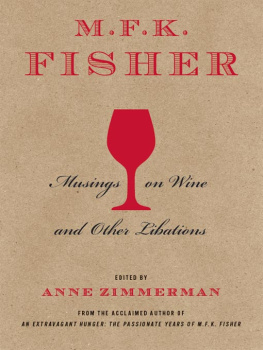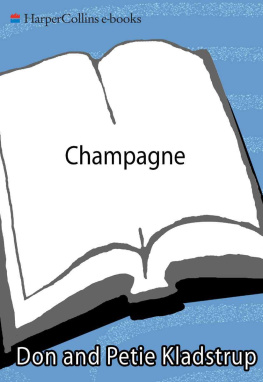Kladstrup D. - Wine and War: The French, the Nazis, and the Battle for Frances Greatest Treasure
Here you can read online Kladstrup D. - Wine and War: The French, the Nazis, and the Battle for Frances Greatest Treasure full text of the book (entire story) in english for free. Download pdf and epub, get meaning, cover and reviews about this ebook. year: 2001, publisher: Broadway, genre: History. Description of the work, (preface) as well as reviews are available. Best literature library LitArk.com created for fans of good reading and offers a wide selection of genres:
Romance novel
Science fiction
Adventure
Detective
Science
History
Home and family
Prose
Art
Politics
Computer
Non-fiction
Religion
Business
Children
Humor
Choose a favorite category and find really read worthwhile books. Enjoy immersion in the world of imagination, feel the emotions of the characters or learn something new for yourself, make an fascinating discovery.
- Book:Wine and War: The French, the Nazis, and the Battle for Frances Greatest Treasure
- Author:
- Publisher:Broadway
- Genre:
- Year:2001
- Rating:5 / 5
- Favourites:Add to favourites
- Your mark:
- 100
- 1
- 2
- 3
- 4
- 5
Wine and War: The French, the Nazis, and the Battle for Frances Greatest Treasure: summary, description and annotation
We offer to read an annotation, description, summary or preface (depends on what the author of the book "Wine and War: The French, the Nazis, and the Battle for Frances Greatest Treasure" wrote himself). If you haven't found the necessary information about the book — write in the comments, we will try to find it.
Kladstrup D.: author's other books
Who wrote Wine and War: The French, the Nazis, and the Battle for Frances Greatest Treasure? Find out the surname, the name of the author of the book and a list of all author's works by series.
Wine and War: The French, the Nazis, and the Battle for Frances Greatest Treasure — read online for free the complete book (whole text) full work
Below is the text of the book, divided by pages. System saving the place of the last page read, allows you to conveniently read the book "Wine and War: The French, the Nazis, and the Battle for Frances Greatest Treasure" online for free, without having to search again every time where you left off. Put a bookmark, and you can go to the page where you finished reading at any time.
Font size:
Interval:
Bookmark:


Wine and War
T h e F r e n c h , t h e N a z i s ,
a n d t h e B a t t l e
f o r F r a n c e s G r e a t e s t T r e a s u r e
Don and Petie Kladstrup
With Dr. J. Kim Munholland, Historical Consultant
Contents
For Regan and Kwan-li,
our daughters and inspiration.
List of Illustrations
and great-grandfathers, vineyard workers in St. milion bring in a harvest in the 1940s. We had a way of living and making wine that was trs ancienne (Robert Drouhin, Burgundy winemaker). Courtesy of Patrimoine Photographique, Paris
flees its home, part of an exodus of more than 10 million people that was touched off by the German invasion. They dont know, nobody knows, where they are going (from the diary of Paul Valry, 1940). Courtesy of Roger-Viollet, Agence Photographique, Paris
in French and German, Reserved for the Wehrmacht. Courtesy of Domaine Pol Roger
Winemakers throughout the country walled off part of their caves to hide their best wines from the Nazis. Courtesy of Patrimoine, Photographique, Paris
in Paris. Courtesy of Patrimoine Photographique, Paris
following annexation of Alsace in 1940. Almost overnight, everything that had been French became German (Johnny Hugel). Courtesy of A. Hugel
give us time to recall and glory in one of Frances purest treasures, our wine, and to alleviate the misery with which we have had to live for so long (message to POWs from the program of Gaston Huets wine fte, 1943).
take a short rest before pushing on. Our foxhole for the night was a cellar. There were beaucoup kegs down there, but they were empty. Boy, were we sad sacks, one soldier said. National Archives photo 111-SC-192224
at Berchtesgaden in the Bavarian Alps. Courtesy of Bettmann/Corbis
left, at the horse races with a German officer. Courtesy of Heinz Bmers, Jr.
of December 5, 1944, residents of the Alsatian village of Riquewihr got their first look at their liberators as a unit of Texans rolled to a stop in front of the Hugels wine store. Courtesy of A. Hugel
champagne producers no longer stamped their bottles, Reserved for the Wehrmacht. Now they were marked, Reserved for Allied Armies. Courtesy of Domaine Pol Roger


Introduction
THE STEEL DOOR WOULD NOT BUDGE.
French soldiers had used everything from lock picks to sledgehammers in an effort to open it. Nothing had worked. Now they decided to try explosives.
The blast shook the mountain peak, sending rocks and debris cascading to the valley below. When the smoke and dust had cleared, the soldiers discovered the door was slightly ajar, just enough for Bernard de Nonancourt, a twenty-three-year-old army sergeant from Champagne, to squeeze through. What he saw left him speechless.
In front of him was a treasure connoisseurs would die for: half a million bottles of the finest wines ever made, wines such as Chteau Lafite-Rothschild and Chteau Mouton-Rothschild, Chteau Latour, Chteau dYquem and Romane-Conti, stacked in wooden cases or resting on racks that filled nearly every inch of the cave. In one corner were rare ports and cognacs, many from the nineteenth century.
One thing, however, jumped out at de Nonancourt: hundreds of cases of 1928 Salon champagne. Five years earlier, while working at another champagne house, he had watched in amazement as German soldiers arrived in the little village of Le Mesnil-sur-Oger and hauled away case after case from the cellars of Salon. Now before him was the very champagne he had seen being stolen.
The young sergeant was thrilled and incredulous.
What was also hard to believe was that all this precious winesitting in a cave near the top of a mountainbelonged to a man who could not have cared less about it. In fact, he did not even like wine.
That man was Adolf Hitler.
The opening of Hitlers cave that day is something Bernard de Nonancourt would never have imagined; before then, he had not even known the cave existed. On May 4, 1945, Sergeant de Nonancourt, a tank commander in General Philippe Leclercs 2nd French Armored Division, was only thinking how good it felt to be alive. Just a few days before, de Nonancourt had heard the good news: the last German units in France had surrendered. His country, at long last, was completely free. Now the Allies were pushing into Germany, their planes dropping thousands of tons of bombs on German industries, airfields and shipyards. Although pockets of resistance remained, German troops were in full retreat and had begun surrendering in large numbers. Everyone knew the war would soon be over.
On that lovely spring day as bright sunlight glinted off newly leafed trees, de Nonancourts army unit found itself tantalizingly close to its destination: the town of the Valhalla for the Nazi gods, lords and masters as historian Stephen Ambrose called it. Hitler had a home here, the Berghof, as well as a mountaintop stone retreat called the Adlershorst, or Eagles Nest. Other Nazis, like Gring, Goebbels, Himmler and Bormann, also had houses here.
It was to Berchtesgaden that the leaders of Europe had come in the late 1930s to be humiliated by Hitler, leaders such as Schuschnigg of Austria and Chamberlain of Britain. It was also where the Nazis shipped much of their loot: gold, jewelry, paintings and other treasures which they had stolen from other occupied countries.
The centerpiece of this Valhalla was the Berghof, Hitlers abode, which, from all outward appearances, looked like a typical chalet nestled on the shoulder of a mountain. It was anything but. As one visitor said, and the flowers growing in window boxes was a palatial fortress unnerving in its strange inner proportions and medieval grandeur and in its display of wealth and power. The living room of the Berghof was sixty feet long and fifty feet wide, so large that people seemed to be lost in it. Heavy wooden furniture, typical of the Alps, stood in front of a huge jade green fireplace. Gobelin tapestries and Italian paintings decorated the walls. In fact, there were so many paintings from so many different schools that the room resembled a picture gallery in an eccentric museum.
What few saw or ever were permitted to visit was Eagles Nest, a fortress situated several thousand feet higher. Hitler himself is said to have gone there only three times, complaining that it was too high, that the air was too thin and that it was hard for him to breathe. Nevertheless, Eagles Nest was a masterpiece of engineering. Built over a three-year period and designed to withstand bombardments and artillery fire, Eagles Nest could be reached only by an elevator that had been cut into the solid rock of the mountain.
Now, with his column paused at the base of the mountain, de Nonancourt stared toward the peak, lost in thought as he tried to imagine the horrors that had been masterminded from that bucolic setting. Suddenly, his thoughts were interrupted by a shout from his commanding officer.
You, de Nonancourt, youre from Champagne, right?
Before Bernard could reply, the officer went on, So you must know something about wine. Get down here right now and come with me.
Next pageFont size:
Interval:
Bookmark:
Similar books «Wine and War: The French, the Nazis, and the Battle for Frances Greatest Treasure»
Look at similar books to Wine and War: The French, the Nazis, and the Battle for Frances Greatest Treasure. We have selected literature similar in name and meaning in the hope of providing readers with more options to find new, interesting, not yet read works.
Discussion, reviews of the book Wine and War: The French, the Nazis, and the Battle for Frances Greatest Treasure and just readers' own opinions. Leave your comments, write what you think about the work, its meaning or the main characters. Specify what exactly you liked and what you didn't like, and why you think so.

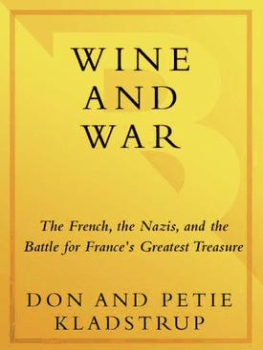
![Jon Bonné - The New French Wine [Two-Book Boxed Set]: Redefining the Worlds Greatest Wine Culture](/uploads/posts/book/443558/thumbs/jon-bonn-the-new-french-wine-two-book-boxed.jpg)
